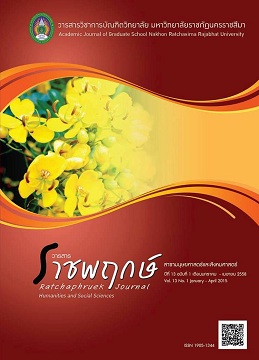ความสัมพันธ์รูป U คว่ำระหว่างความวิตกกังวล และผลสัมฤทธิ์ทางการเรียนวิชาสถิติ ของนักศึกษามหาวิทยาลัยกรุงเทพ
Main Article Content
บทคัดย่อ
การศึกษาครั้งนี้มีวัตถุประสงค์เพื่อตรวจสอบความเป็นไปได้ของความสัมพันธ์แบบสมการกำลังสองรูป U คว่ำระหว่างความวิตกกังวลและผลสัมฤทธิ์ทางการเรียนวิชาสถิติของนักศึกษามหาวิทยาลัยกรุงเทพ ตลอดภาคการศึกษาที่ 2 ปีการศึกษา 2556 นักศึกษาคณะนิเทศศาสตร์ที่ลงทะเบียนเรียนวิชาสถิติเพื่อสังคมศาสตร์ทั้งหมด 197 คน ต้องทำแบบทดสอบเพื่อวัดผลสัมฤทธิ์การเรียนวิชาสถิติรวม 6 ครั้งควบคู่กับแบบวัดความวิตกกังวลในการเรียนวิชาสถิติของ Cruise และ Wilkins (1980) และแบบวัดแรงจูงใจใฝ่สัมฤทธิ์ของ Schwartz ทุกคน ผลการศึกษาด้วยการวิเคราะห์ความผันแปรหลายตัวแบบวัดซ้ำ การวิเคราะห์สหสัมพันธ์ และการวิเคราะห์การถดถอยแบบเชิงชั้นพบว่า ในแต่ละครั้งของการทดสอบ นักศึกษามีความวิตกกังวลลดลงและความวิตกกังวลที่เกิดขึ้นมีความสัมพันธ์กับผลสัมฤทธิ์ทางการเรียนในระดับสูงโดยความสัมพันธ์รูป U คว่ำสามารถทำนายผลสัมฤทธิ์ทางการเรียนวิชาสถิติของนักศึกษาได้ดีกว่าความสัมพันธ์แบบเส้นตรง ซึ่งแสดงให้เห็นว่านักศึกษาที่มีความวิตกกังวลในระดับที่เหมาะสมไม่มากหรือไม่น้อยเกินไปจะมีผลสัมฤทธิ์ทางการเรียนวิชาสถิติสูงสุด นอกจากนี้ยังพบว่าแรงจูงใจใฝ่สัมฤทธิ์ไม่ได้เป็นปัจจัยเกื้อหนุนให้เกิดความสัมพันธ์รูป U คว่ำระหว่างความวิตกกังวลและผลสัมฤทธิ์ทางการเรียนวิชาสถิติของนักศึกษา
Article Details
เอกสารอ้างอิง
Berk, R. A. and J. P. Nanda. (1998). Effects of Jocular Instructional Methods on Attitude, Anxiety, and Achievement in Statistics Courses. [Online]. Available : http://www.amstat.org./citation [2013, December 3].
Bhuain, S. N., B. Menguc and R. Borsboom. (2005). Stressors and Job Outcomes in Sales: A Triphasic Model versus a linear-quadraticinteractive Model. [Online]. Available : http://www.sciencedirect.com/citation. [2013, October 22].
Cruise, R. and E. Wilkins. (1980). STARS : Statistical Anxiety Rating Scale. Unpublished manuscript, Andrews University, Michigan.
Cruise, R., R. Cash. and D. Bolton. (1985). “Development and Validation of an Instrument to Measure Statistical Anxiety.” ASA Proceedings of the Section on Statistical Education Section. pp. 92-97. Alexandria, VA : American Statistical Association.
Feather, N. T., M. A. Norman and A. Worsley. (1998). “Values and Valences : Variables Related to the Attractiveness and Choice of Food in Difference Contexts.” Journal of Applied Social Psychology. 28(7) : 639-656.
Gal, I. and L. Ginsburg. (1994). “The Role of Beliefs and Attitudes in Learning Statistics: Towards an Assessment Framework.” Journal of Statistics Education. 2 : 1-54.
Kais, K. and L. Raudsepp. (2004). “Cognitive and Somatic Anxiety and Self-confidence in Athletic Performance of Beach Volleyball.” Perceptual and Motor Skills. 98(2) : 439-449.
Onwuegbuzie, A. J. and V. A. Wilson. (2003). Statistics Anxiety : Nature, Etiology Antecedents, Effects, and Treatments– a Comprehensive Review of the Literature. [Online]. Available : http://www.eric.ed.gov/citation. [2014, May 15].
Onwuegbuzie, A. J. and M. Seaman. (1995). “The Effect of Time Constraints and Statistics Test Anxiety on Test Performance in a Statistics Course.” Journal of Experimental Education. 63(2) : 115-124.
Sarid, O. and Orthers. (2004). Academic Stress, Immunological Reaction, and Academic Performance among Students of Nursing and Physiotherapy. [Online]. Available : http://www.onlinelibrary.wiley.com/citation. [2013, October 25].
Yerkes, R. and Dodson, J. (1908). The Relation of Strength of Stimulus to Rapidity of Habitformation. [Online]. Available : http://www.onlinelibrary.wiley.com/citation. [2013, November 20].
Zanakis, S. H. and E. R. Valenzi. (1997). Student Anxiety and Attitudes in Business Statistics. [Online]. Available : http://heldref-publications. metapress/citation. [2014, April 29].
Zeidner, M. (1991). “Statistics and Mathematics Anxiety in Social Science Students : Some Interesting Parallels”. British Journal of Educational Psychology. 61(3) : 319-328.


